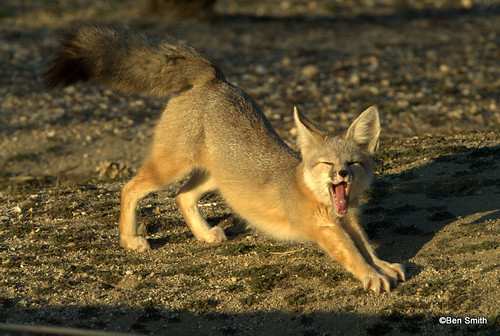A quick introduction to the desert kit fox project
I'm Dipika Kadaba, a graduate student at Duke University. During my internship at the Center for Biological Diversity in the Summer of 2012, I worked on a petition to list the desert kit fox as threatened under the California Endangered Species Act. While writing the petition, I realised there were large gaps in the literature - specifically, baseline information about numbers of foxes. These gaps led to the petition being rejected by California state authorities. The Desert Kit Fox Project was born of the need for baseline data about this population, and ideas sparked by graduate coursework in innovative non-invasive wildlife monitoring techniques.
Desert kit foxes (Vulpes macrotis arsipus), are a diminutive subspecies of kit fox that are found in arid regions. Very little is known about their population in California, and their desert habitat in the state is facing numerous growing threats from human development. In 2012, foxes in and around a solar energy project began dying from a stress-induced disease outbreak.
![]()
A desert kit fox, by Ben Smith
Source
This summer I aim to study where desert kit foxes occupy available habitat, and how the landscape, vegetation, prey species, and human disturbance affects them.
The two things that set this study apart from a conventional survey is the use of a low-cost quadcopter drone to perform rapid aerial surveys, and the recording of desert kit fox footprints for the purpose of developing an identification algorithm for the species. All the techniques we develop are designed to be adaptable to other desert species, and we will also generate data that is informative about the entire desert ecosystem.
Another motivating factor behind my decision to involve crowdfunding and social media in my research was to share this experience with people in my life, connect with new people who share my love for the natural world, and finally, to make full use of being a scientist who lives and works in the age of the internet. Thank you for being a part of this project.
What We Need and What You Get
1) We need help buying equipment! If you sponsor a specific item by claiming it as a perk, we will send it to you after we use it (as gently as possible!) through the summer. The cost of sponsoring equipment is calculated by adding the cost of the unit, tax, shipping costs to us and to you, and indiegogo's fees. GPS Units, a GoPro, and a terrifyingly awesome quadcopter drone can be claimed in this way. Who doesn't already have drones on their shopping list? Buy one and support a great cause! (Or, if you have used equipment that you can lend us for the duration of the project, get in touch!)
EQUIPMENT DISCLAIMER: Equipment will be used as carefully as possible, and they might bear some signs of use in their line of duty. On the off chance that the equipment fails and becomes non-functional, we will send you a new unit.
2) We also need money for non-returnable expenses like scent bait, materials to build track plate stations, camping equipment, and a 4WD rental + gas for difficult terrain. This is where the main perks come in.
Wristbands: A 100% silicone eco-friendly wristband that reads "The Desert Kit Fox Project". Sport your support for the project, and start conversations about the desert's most charming canine.
Postcards: We'll post you a desert themed postcard with a handwritten message of thanks, to remind you of that time you supported desert kit fox research and how your biologist buddies fended off heatstroke in the desert summer.
Photo prints: As we survey and make our way through the Sonoran desert landscape, we'll be photographing the landscape, our exploits, and desert critters - including aerial shots taken from the drone, and discrete camera trap stills. We'll put up a gallery of all our best shots, and we'll send you a photo print of your favorite one. Don't forget to include your e-mail address!
T-shirts: (My personal favorite!) A gray cotton t-shirt with the official project logo.
![]()
Project logo, designed by graphic artist chackosan.blogspot.in
Access this chart to choose your size: Size Chart (XXLs and larger are available too, they just don't show up on the chart)
Wear your love for desert kit foxes, and if you run into one of us, we'll be t-shirt buddies.
Track casts and plates: We'll be laying out powdered contact paper and sanded track plates to capture desert critter footprints to enumerate them and record the prints. We'll also be stumbling across footprints in the wild.
![]()
Desert Tracks
We'll send you a plaster cast and track paper pair so you can keep a piece of the wild with you, without taking anything from it. If you're familiar with the Sonoran desert and have a species you're fond of, let us know and we'll reserve it for you if we find it!
Camping trips: Come spend time with us! We want to spend time with you. Spot desert critters with us as we work, and at night, lie back under the desert sky and watch the universe expand.
Funder recognition: Be a Desert Kit Fox Project godparent. We'll love you for it and acknowledge your contribution in all publications that the project generates. Plus everything else we can give you.
All contributions earn our undying gratitude.
The Impact
Current management of the desert kit fox is entirely inadequate to monitor and prevent population declines due to the range of current and emerging threats to this subspecies. The listing petition discusses the threats in detail for 30 pages.
The expected results of the study are:
- Desert kit fox occupancy levels, i.e. how frequently they occupy habitat that is available to them.
- How landscape features, vegetation communities and cover, prey species numbers and compositions, and human disturbance like signs of vehicles and debris affects desert kit fox occupancy levels, as well as the correlations between all these elements themselves.
These ecological data provide an important baseline for further studies on the species, and also aids evidence-based decisions about the management and conservation of desert kit foxes and their habitat.
The desert kit fox can serve as an important umbrella species in their desert ecosystem as they are wide-ranging and their habitat requirements include those of many other species, i.e. creosote scrub bush dwelling animals such as the desert tortoise, burrowing owl, mohave ground squirrel, and others.
The broader impacts of this study include:
- Development of a low cost, low altitude, quadcopter drone for aerial surveys. The use of drones for conservation is ripe for development as technology comes of age. The quadcopter that we will use can autonomously follow waypoints that are programmed using autopilot software, while it carries a video camera payload. This involves many firsts - the use of drones for this species and this ecosystem, and the first use of a quadcopter for wildlife conservation research to the best of our knowledge. Drones are not often used for conservation in the US due to FAA regulations, so the system that we develop within the regulations can serve as a useful reference for other researchers. The manufacturer of the drone, 3D robotics, maintain open source technology which allows us to keep the cost of the drone as low as possible.
- The development of an identification algorithm for desert kit foxes based on the sand and paper tracks we capture, with the use of FIT - Footprint Identification Technology - by WildTrack. FIT provides high levels of accuracy in identifying at the species, individual, age-class and sex levels. The creation of this algorithm will enable low cost non invasive population monitoring in the future. There's a lot of exciting things going on in the world of wildlife footprints; visit WildTrack at http://www.wildtrack.org/.




















































